Related Research Articles

The House of Tudor was a royal house of largely Welsh and English origin that held the English throne from 1485 to 1603. They descended from the Tudors of Penmynydd and Catherine of France. Tudor monarchs ruled the Kingdom of England and its realms, including their ancestral Wales and the Lordship of Ireland for 118 years with five monarchs: Henry VII, Henry VIII, Edward VI, Mary I and Elizabeth I. The Tudors succeeded the House of Plantagenet as rulers of the Kingdom of England, and were succeeded by the House of Stuart. The first Tudor monarch, Henry VII of England, descended through his mother from a legitimised branch of the English royal House of Lancaster, a cadet house of the Plantagenets. The Tudor family rose to power and started the Tudor period in the wake of the Wars of the Roses (1455–1487), which left the main House of Lancaster extinct in the male line.
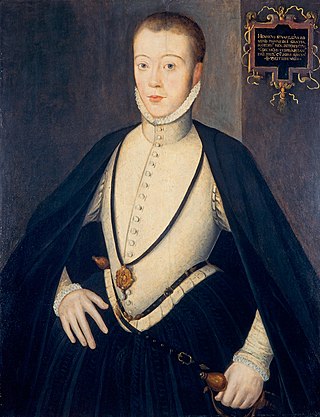
Henry Stuart, Lord Darnley, was an English nobleman who was the second husband of Mary, Queen of Scots, and the father of James VI of Scotland and I of England. Through his parents, he had claims to both the Scottish and English thrones, and from his marriage in 1565 he was king consort of Scotland. Less than a year after the birth of his son, Darnley was murdered at Kirk o' Field in 1567. Many contemporary narratives describing his life and death refer to him as simply Lord Darnley, his title as heir apparent to the Earldom of Lennox.

Margaret Plantagenet, Countess of Salisbury, also called Margaret Pole as a result of her marriage to Sir Richard Pole, was the only surviving daughter of George Plantagenet, Duke of Clarence, a brother of Kings Edward IV and Richard III, by his wife Isabel Neville. Margaret was one of just two women in 16th-century England to be a peeress in her own right without a husband in the House of Lords. As one of the few members of the House of Plantagenet to have survived the Wars of the Roses, she was executed in 1541 at the command of King Henry VIII, the second monarch of the House of Tudor, who was the son of her first cousin, Elizabeth of York. Pope Leo XIII beatified her as a martyr for the Roman Catholic Church on 29 December 1886.
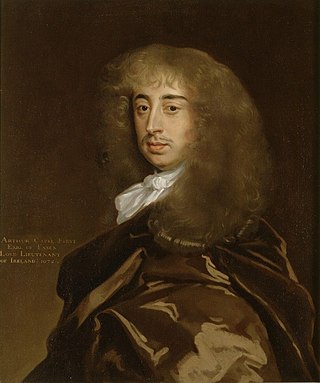
Arthur Capell, 1st Earl of Essex, PC, also spelt Capel, of Cassiobury House, Watford, Hertfordshire, was an English statesman.
Robert Ferguson was a Scottish presbyterian minister, conspirator and political pamphleteer, known as "the Plotter".

Thomas Howard, 4th Duke of Norfolk, was an English nobleman and politician. He was a second cousin of Queen Elizabeth I and held many high offices during the earlier part of her reign.

Titus Oates was an English priest who fabricated the "Popish Plot", a supposed Catholic conspiracy to kill King Charles II.

Anthony Ashley Cooper, 1st Earl of Shaftesbury PC FRS, 22 July 1621 to 21 January 1683, was an English politician and statesman from Dorset. He held senior political office under both the Commonwealth of England and Charles II, serving as Chancellor of the Exchequer from 1661 to 1672, and Lord Chancellor from 1672 to 1673. During the 1679 to 1681 Exclusion Crisis, he headed the movement to bar the Catholic heir, James II from the succession, often seen as the origin of the Whig party. He was also a patron of the political philosopher John Locke, with whom he collaborated with in writing the Fundamental Constitutions of Carolina in 1669.

The Popish Plot was a fictitious conspiracy invented by Titus Oates that between 1678 and 1681 gripped the kingdoms of England and Scotland in anti-Catholic hysteria. Oates alleged that there was an extensive Catholic conspiracy to assassinate Charles II, accusations that led to the executions of at least 22 men and precipitated the Exclusion Bill Crisis. Eventually, Oates's intricate web of accusations fell apart, leading to his arrest and conviction for perjury.
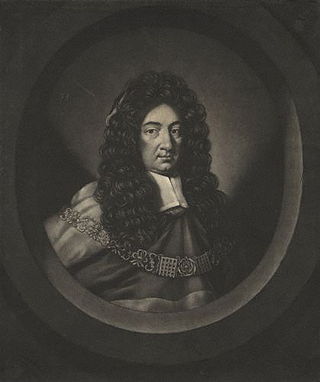
Sir William Scroggs was Lord Chief Justice of England from 1678 to 1681. He is best remembered for presiding over the Popish Plot trials, where he was accused of showing bias against the accused.
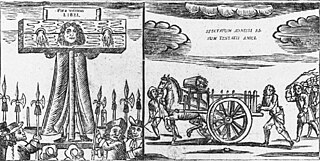
Thomas Dangerfield was an English conspirator, who became one of the principal informers in the Popish Plot. His violent death at the hands of the barrister Robert Francis was clearly a homicide, although whether the killing was murder or manslaughter was a matter of considerable public debate at the time.

Sir Roger L'Estrange was an English pamphleteer, author, courtier, and press censor. Throughout his life L'Estrange was frequently mired in controversy and acted as a staunch ideological defender of King Charles II's regime during the Restoration era. His works played a key role in the emergence of a distinct 'Tory' bloc during the Exclusion Crisis of 1679-81. Perhaps his best known polemical pamphlet was An Account of the Growth of Knavery, which ruthlessly attacked the parliamentary opposition to Charles II and his successor James, Duke of York, placing them as fanatics who misused contemporary popular anti-Catholic sentiment to attack the Restoration court and the existing social order in order to pursue their own political ends. Following the Exclusion Crisis and the failure of the nascent Whig faction to disinherit James, Duke of York in favour of Charles II's illegitimate son James, 1st Duke of Monmouth L'Estrange used his newspaper The Observator to harangue his opponents and act as a voice for a popular provincial Toryism during the 'Tory Reaction' of 1681-85. Despite serving as an MP from 1685-89 his stock fell under James II's reign as his staunch hostility to religious nonconformism conflicted with James' goals of religious tolerance for both Catholics and Nonconformists. The Glorious Revolution of 1688 and the collapse of the Restoration political order heralded the end of L'Estrange's career in public life, although his greatest translation work, that of Aesop's Fables, saw publication in 1692.
Thomas Thwing (1635–1680) was an English Roman Catholic priest and martyr, executed for his supposed part in the Barnbow Plot, an offshoot of the fabricated Popish Plot invented by Titus Oates. His feast day is 23 October.
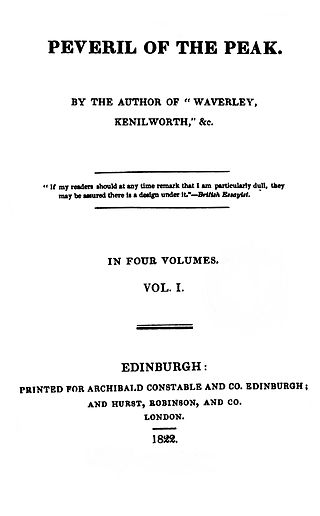
Peveril of the Peak (1823) is the longest novel by Sir Walter Scott. Along with Ivanhoe, Kenilworth, and Woodstock this is one of the English novels in the Waverley novels series, with the main action taking place around 1678 in the Peak District, the Isle of Man, and London, and centring on the Popish Plot.
Miles Prance was an English Roman Catholic craftsman who was caught up in and perjured himself during the Popish Plot and the resulting anti-Catholic hysteria in London during the reign of Charles II.
Crystal Gail Mangum is a former exotic dancer and convicted murderer from Durham, North Carolina, who is best known for having made false allegations of rape against lacrosse players in the 2006 Duke lacrosse case. The fact that Mangum was a black woman working in the sex industry, while the accused were all white men, created extensive media interest and academic debate about race, class, gender and the politicization of the justice system.

Elizabeth Cellier, commonly known as Mrs. Cellier or 'Popish Midwife', was a notable Catholic midwife in seventeenth-century England. She stood trial for treason in 1679 for her alleged part in the 'Meal-Tub Plot' against the future King James II, but was eventually freed. Cellier was later imprisoned for allegations made in her 1680 work Malice Defeated, in which she recounted the events of the alleged conspiracy against the future King. She later became a pamphleteer and advocated for advancements in the field of midwifery. Cellier published A Scheme for the Foundation of a Royal Hospital in 1687, where she outlined plans for a hospital and a college for instructions in midwifery, as well as proposing that midwives of London should enter into a corporation and use their fees to establish parish houses where any woman could give birth. Cellier resided in London, England until her death.
Maurus Corker was an English Benedictine who was falsely accused and imprisoned as a result of the fabricated Popish Plot, but was acquitted of treason and eventually released.
John Arnold, widely known as John Arnold of Monmouthshire, was a Welsh Protestant politician and Whig MP. He was one of the most prominent people in Monmouthshire in the late 17th century. A stark anti-Catholic, he was a notable figure during the Popish plot and the suppression of Catholicism in the country. Arnold represented the constituencies around Monmouth and Southwark in Parliament in the 1680s and 1690s. His strong anti-Catholic beliefs and insurgences against Catholic priests made him an unpopular and controversial figure amongst his peers and in his native Monmouthshire. In his later years, his behaviour became increasingly eccentric, and he was widely believed to have faked an attempt on his own life. Amongst his associates were Titus Oates and Anthony Ashley Cooper, 1st Earl of Shaftesbury.
Ann Smith was an English anti-Catholic political activist. A devout Baptist, she and her family sheltered the rebel 9th Earl of Argyll when he was in hiding in London and fled with him to the Spanish Netherlands in 1683. She lived with her husband in Utrecht and following his death funded Argyll's Rising in Scotland and the contemporaneous Monmouth Rebellion in England. She hosted fellow conspirator Elizabeth Gaunt in Amsterdam and received a royal pardon for her activism in 1686, after which time records of her life cease.
References
- 1 2 3 4 5 6 7 "Clark, Margaret [Margret]". Oxford Dictionary of National Biography (online ed.). Oxford University Press. doi:10.1093/ref:odnb/67999.(Subscription or UK public library membership required.)
- ↑ UK Retail Price Index inflation figures are based on data from Clark, Gregory (2017). "The Annual RPI and Average Earnings for Britain, 1209 to Present (New Series)". MeasuringWorth. Retrieved 11 June 2022.
- ↑ Kittredge, Katharine (2003). Lewd and Notorious: Female Transgression in the Eighteenth Century. University of Michigan Press. p. 169. ISBN 978-0-472-08906-2 . Retrieved 22 July 2020.
- 1 2 Knoppers, Laura Lunger (2009). The Cambridge Companion to Early Modern Women's Writing. Cambridge University Press. p. 148. ISBN 978-1-139-82836-9 . Retrieved 22 July 2020.
- ↑ Clark, S. (2003). Women and Crime in the Street Literature of Early Modern England. Springer. p. 38. ISBN 978-0-230-00062-9 . Retrieved 22 July 2020.